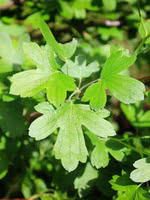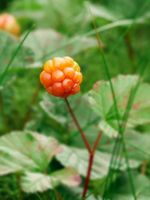Mon-Fri 9am - 5pm Mountain time
Golden Currant vs Cloudberry
Ribes aureum
Rubus chamaemorus
SOLD OUT
NOT AVAILABLE THIS SEASON - MIGHT RETURN
Golden Currant produces berries for jams, jellies, sauces and even pemmican. This currant bush is very dense, allowing for use as a hedge, windbreak, or wildlife habitat.
This plant is also a very popular rootstock to graft popular red and white currant varieties to. The resulting plants are taller, more productive, and easier to harvest.
Cloudberry produces berries which taste tart and tangy with a sweet, floral hint. The berries have a creamy texture when overripe. They are often used to make jams, juices, and liquors. The berries are a pale red colour and when ripe turn more orange/amber. They do not grow very tall, generally reaching only 10-25 cm.
Cloudberry has distinct male and female plants. In order to produce berries, both must be present and pollinate with each other. Berries are produced at maturity, typically 5-7 years, and produce 1 berry per stem. The plant spreads naturally as they grow using modified underground stems (rhizomes), forming more plants over time in the same area.
This plant can be found wild in Canada’s boreal forest. In Newfoundland and Labrador, this plant is known as the Bakeapple and is a significant regional food. Similarly the Côte-Nord region of Quebec also has a long history of using this berry.
Note: Cloudberries require very specific soil conditions. They need well-drained soil with a pH between 3.5 and 5.0. Also sensitive to salt and dry conditions.
Note: Our seedlings are grown from seed and are too young to identify their sex.

